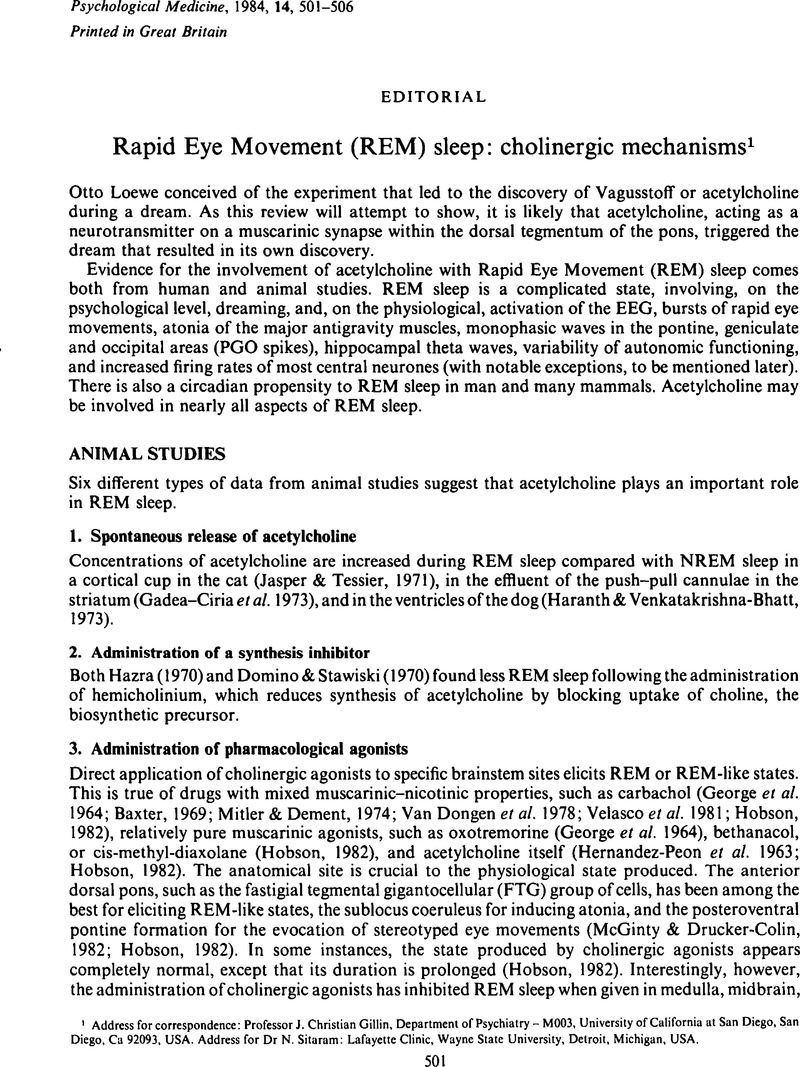Crossref Citations
This article has been cited by the following publications. This list is generated based on data provided by Crossref.
Kowalski, Andrew
Stanley, Robb O.
Dennerstein, Lorraine
Burrows, Graham D.
and
Maguire, Kay P.
1985.
The Sexual Side-Effects of Antidepressant Medication: A Double-Blind Comparison of Two Antidepressants in a Non-Psychiatric Population.
British Journal of Psychiatry,
Vol. 147,
Issue. 4,
p.
413.
Christian Gillin, J.
and
Borbély, Alexander A.
1985.
Sleep: a neurobiological window on affective disorders.
Trends in Neurosciences,
Vol. 8,
Issue. ,
p.
537.
Webster, Harry H.
and
Jones, Barbara E.
1988.
Neurotoxic lesions of the dorsolateral pontomesencephalic tegmentum-cholinergic cell area in the cat. II. Effects upon sleep-waking states.
Brain Research,
Vol. 458,
Issue. 2,
p.
285.
Smith, Carlyle
and
Kelly, Gina
1988.
Paradoxical sleep deprivation applied two days after end of training retards learning.
Physiology & Behavior,
Vol. 43,
Issue. 2,
p.
213.
Bliwise, D.L.
Tinklenberg, J.
Yesavage, J.A.
Davies, H.
Pursley, A.M.
Petta, D.E.
Widrow, L.
Guilleminault, C.
Zarcone, V.P.
and
Dement, W.C.
1989.
REM latency in Alzheimer's disease.
Biological Psychiatry,
Vol. 25,
Issue. 3,
p.
320.
Jones, B.E.
1991.
Paradoxical sleep and its chemical/structural substrates in the brain.
Neuroscience,
Vol. 40,
Issue. 3,
p.
637.
Bahro, M.
Riemann, D.
Stadtmüller, G.
Berger, M.
and
Gattaz, W.F.
1993.
REM sleep parameters in the discrimination of probable Alzheimer's disease from old-age depression.
Biological Psychiatry,
Vol. 34,
Issue. 7,
p.
482.
Smith, Carlyle
1995.
Sleep states and memory processes.
Behavioural Brain Research,
Vol. 69,
Issue. 1-2,
p.
137.
de Saint Hilaire, Zara
Gaillard, Jean-Michel
Sarbach, Sabine Detolle
and
Guez, David
1995.
Effect of a new cognitive drug-enhancer S-12024-2 on EEG sleep recordings in rats.
Pharmacology Biochemistry and Behavior,
Vol. 52,
Issue. 4,
p.
819.
Bernstein, A. S.
Schnur, D. B.
Bernstein, P.
Yeager, A.
Wrable, J.
and
Smith, S.
1995.
Differing patterns of electrodermal and finger pulse responsivity in schizophrenia and depression.
Psychological Medicine,
Vol. 25,
Issue. 1,
p.
51.
Smith, Carlyle
1996.
Sleep states, memory processes and synaptic plasticity.
Behavioural Brain Research,
Vol. 78,
Issue. 1,
p.
49.
Gupta, Sanjay
Popli, Anand
Bathurst, Ellen
Hennig, Lisa
Droney, Thomas
and
Keller, Peggy
1998.
Efficacy of cyproheptadine for nightmares associated with posttraumatic stress disorder.
Comprehensive Psychiatry,
Vol. 39,
Issue. 3,
p.
160.
Wetterling, Tilman
2002.
Organische psychische Störungen.
p.
89.
Jones, Barbara E.
2005.
From waking to sleeping: neuronal and chemical substrates.
Trends in Pharmacological Sciences,
Vol. 26,
Issue. 11,
p.
578.
Magosso, E.
Ursino, M.
Zaniboni, A.
Provini, F.
and
Montagna, P.
2007.
Visual and computer-based detection of slow eye movements in overnight and 24-h EOG recordings.
Clinical Neurophysiology,
Vol. 118,
Issue. 5,
p.
1122.
Boucetta, Soufiane
and
Jones, Barbara E.
2009.
Activity Profiles of Cholinergic and Intermingled GABAergic and Putative Glutamatergic Neurons in the Pontomesencephalic Tegmentum of Urethane-Anesthetized Rats.
The Journal of Neuroscience,
Vol. 29,
Issue. 14,
p.
4664.
Gorini, C.
Philbin, K.
Bateman, R.
and
Mendelowitz, D.
2010.
Endogenous Inhibition of the Trigeminally Evoked Neurotransmission to Cardiac Vagal Neurons by Muscarinic Acetylcholine Receptors.
Journal of Neurophysiology,
Vol. 104,
Issue. 4,
p.
1841.
Becchetti, Andrea
2012.
Neuronal Nicotinic Receptors in Sleep-Related Epilepsy: Studies in Integrative Biology.
ISRN Biochemistry,
Vol. 2012,
Issue. ,
p.
1.
Zhang, Bin
Hao, Yanli
Li, Xueli
Ren, Yanzhen
Zhou, Ping
and
Liu, Wuhan
2013.
An 8-week, open-label study to evaluate the effect of sertraline on the polysomnogram of depressive patients with insomnia.
Sleep and Biological Rhythms,
Vol. 11,
Issue. 3,
p.
165.
McGrane, Ian R.
Leung, Jonathan G.
St. Louis, Erik K.
and
Boeve, Bradley F.
2015.
Melatonin therapy for REM sleep behavior disorder: a critical review of evidence.
Sleep Medicine,
Vol. 16,
Issue. 1,
p.
19.



